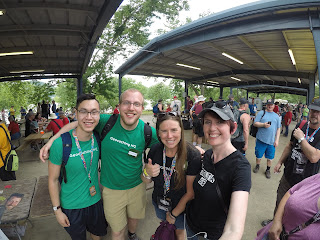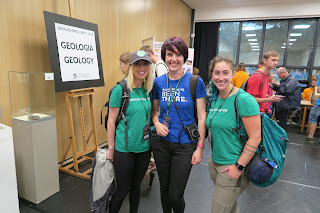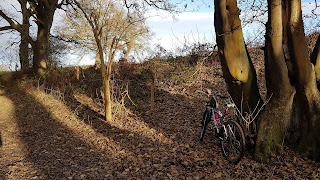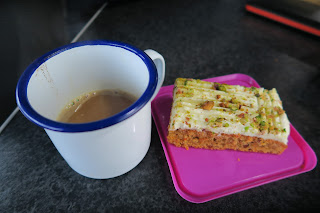We had a lovely few days at home with our family over Christmas, it was great to get everyone together and we even managed to get out for a couple of good walks.
On Christmas Eve we walked up to Rivington Pike, it was a lovely sunny day and the views were fantastic.
|
|
 |
| Rivington Pike |
|
Before Christmas dinner we headed up to the Forest of Bowland and enjoyed a very foggy walk from Victoria Tower, Quernmore on Hare Appletree Fell.
 |
| Victoria Tower |
After Christmas we'd planned to get away in the camper-van for a few days as we didn't need to be back at work until the New Year.
Thursday - First of all we needed to head down to Alcester to visit family. Whilst we were there we did a spot of maintenance on a couple of caches in the area. We've archived a lot of our caches when we moved but have been trying to keep a few of them going. Then we headed up to Sheffield to drop our daughter off before continuing on towards Norfolk.
Our main focus for the trip was to do the new virtuals, Wherigos and LQs.
First stop was a virtual in a place called Digby. An old village lock up. It was dark by the time we arrived but it didn't matter, we were still able get a photo.
As there were so many caches to choose from on our route we decided to just stop off and find Church Micros if they were nearby.
On Friday we enjoyed a wander around West Lynn to play
West Lynn ferry walkabout Wherigo.
 |
| Church Micro 11126... West Lynn |
 |
| View of Kings Lynn from West Lynn |
The days are so short at the moment that it makes fitting everything in to daylight hours quite difficult, so by the time we reached Sandringham the sun was setting and we had to have a very brisk walk around the Sculpture Park to do the
virtual.
Saturday morning our first stop was Wells-next-the-Sea to do the virtual. This is our first visit here and we loved it, although judging by the size of the car park it probably gets very crowded at peak times.
We'd really like to make 2019 the year we finally complete the Little Quest series. We found our first one in 2008 and even though we finished our county map a long time ago we never got round to doing the LQ caches. Out of the 47 we only have a handful left to find and the plan was to find three on this trip.
 |
| LQ:Norfolk |
Next stop was
Burgh Castle Wherigo. This was an unexpected little gem. We'd never heard of Burgh Castle before this Wherigo.
The late 3rd century 'Saxon Shore' fort at Burgh Castle was built as part of the Roman network of coastal defences, it was probably abandoned just over a hundred years later. Three of the imposing stone walls survive today, almost to their original height. This is one of the best preserved Roman monuments in Britain. The fourth wall collapsed into the surrounding marshes a long time ago.
We'd never come across a round tower church before and after reading up about them it seems they are found mainly in England and mostly in East Anglia.
 |
| Church Micro 9121...Burgh Castle |
There are about 185 surviving examples in the country. According to the cache listing for the Church Micro at Burgh Castle there are 124 are in Norfolk, 38 in Suffolk, 6 in Essex, 3 in Sussex and 2 each in Cambridgeshire and Berkshire.
 |
| Church Micro 7644...Belton |
Apparently round tower churches are found in areas lacking normal building stone and are built out of flint. Corners are difficult to construct in flint, hence the thick, round walls of the towers.
Then we drove to Somerleyton to do the new virtual at the Hovercraft memorial column. This is a great place to have a virtual.
Next place on the whistle-stop tour was Southwold Pier to do an old virtual called
Pier Pressure. Once again it was a race against daylight. This has been on our to-do list for a very long time.
Southwold Pier has quite an interesting history. It was built in 1900 and was originally 810 ft long. It was built as a landing stage for the Belle steamships that travelled from London Bridge. It's hard to believe now but until the early 1930s most holidaymakers travelled by sea and Southwold was a popular destination. Over the years, as the roads improved the steamships lost business and Belle bought coaches instead.
 |
| The Pier Water Clock |
In 1934 the T-shaped landing stage was swept away by a storm and was never replaced. At the outbreak of World War II engineers exploded a section of the Pier to prevent a German landing. A further section was destroyed by a drifting sea mine in 1941. In 1979 another storm reduced the length to just 60ft.
Various other changes occurred to the pier over time and in 1987 it was privately bought and by 2001 the pier was now at its current length of 623 feet.
It was sold again in 2005 and became a family run business by Stephan and Antonia Bournes and in 2013 was sold to Gough Hotels who continue to make improvements.
If you visit you must visit the brilliant Tim Hunkin's Under the Pier Show - it's a collection of coin-operated arcade machines all created by the Tim Hunkin the engineer. You might be familiar with him from The Secret Life of Machines on Channel 4.
We came out just in time to see the sun setting.
We regularly see wild animals when out and about, it's very hard to capture them as they move so fast, quite often we are lucky enough to capture them on our dashcam - the wild boar was posted on a previous
blog. Here is a short clip of a small deer we saw down a country lane.
Sunday morning we were up bright and early ready to explore Norwich. Another first for us as we'd never been to Norwich before.
Luckily we found free parking so enjoyed wandering around for a few hours finding caches.
As we approached this sculpture I thought straight away it looked like a belly, apparently that's what a lot of other people think too. It was created by Bernard Meadows and is entitled Public Sculpture. It was commissioned for the Easter Daily Press in 1968 and was installed outside Prospect House in Norwich in 1970. We couldn't decide if we liked it or not 😀
After this we headed to LQ: Suffolk and by the time we got there, you guessed it, it was dark. A bit of a rummage and we soon located the cache.
 |
| LQ:Suffolk |
On Monday we headed to Rutland stopping off at Peterborough on the way to play a couple of Wherigos.
 |
| LQ:Rutland |
 |
| Normanton Church |
Wow what an amazing church. We'd never been to Rutland Water before so had never seen the church. St Matthew's Church is a grade II listed building, and was built between 1826 and 1829. It was based on the design of St John's, Smith Square in Westminster. The building was once the private chapel for the Normanton Estate but was de-consecrated in 1970 as it was due to be demolished as part of the reservoir construction and luckily it was saved after public outcry. When it was time to flood the area it became obvious that the church would be partially submerged once the high water level was reached. It was decided that the lower level of the church should be filled with rubble and topped with concrete to create a new floor making it approximately 60cm above water level. A causeway was built to prevent it being on an island. Boulders have been put in place as a defensive breakwater.
Unfortunately a wedding was due to take place on the day of our visit so we were unable to go inside.
After this we drove around the other side of the reservoir to The Great Tower virtual before starting the long journey home.
It was a really fun trip and we were really lucky with the weather, it was very mild every day and it didn't rain once. We'll be returning to Norfolk, preferably when there's more daylight.







































































